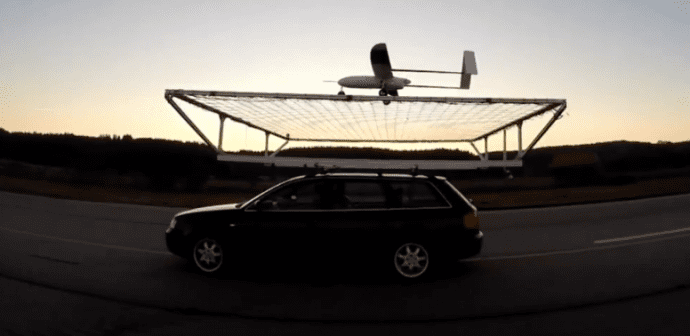German researchers successfully land the world’s first fully autonomous drone on a moving vehicle
For the first time ever, an autonomous drone flying at 45 kmph has successfully landed itself on a moving car. In the past, drones have landed on a ship floating in the sea.
Researchers at the German Aerospace Centre or DLR, tested the three-metre-long, 20-kilogram unmanned aerial vehicle (UAV) in an air field in Bavaria. They put a suspended net on top of a car, drove it at 45mph, and waited for the drone to match speed. The roof of the car it landed on was equipped with a platform that had optical markers, guiding the drone to its landing.
According to the engineers, the drone can navigate its position – accurate to within 50 cm – relative to the mobile platform. The drone’s camera scans the landing platform that looks a lot like a QR code, and then lowers itself gently into the net.
The fixed-wing aircraft is aimed at fragile solar-powered planes and was developed without landing gear to make it ultralight.
This “creates more space for scientific instruments,” said the German Aerospace Centre, which means it could replace failed communications during a natural disaster or emergency, or land in adverse conditions like storms.
The other advantage of getting rid of landing gear and wheels is that the weight of the drone can be reduced, and it can stay airborne for not only days at a time but also months or even years continuously.
Although the car in the video is being driven by a human, the researchers said: “In the future, in practical applications, a robotic vehicle without a driver could be used.” DLR writes:
The major advantage of this system is that the movement of the UAV and the ground vehicle are synchronised in real time using the developed algorithms. With both vehicles moving at the same velocity, the landing resembles a vertical helicopter landing when seen from the ground vehicle. Thereby, the horizontal velocity components are close to zero, making the landing phase simpler and safer. In the experiments performed to date, flight operations safety rules required a driver to be present in the car. The driver received calculated control commands via a graphical display, which instructed faster or slower driving. In the future, in practical applications, a robotic vehicle without a driver could be used.
Have a look at the robot land on the human-driven car in the video below:

